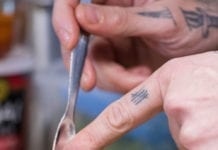What makes someone want to open a restaurant? Statistics show the foodservice industry has one of the highest failure rates for startups in North America, with 60 per cent of restaurants failing within the first three years. It makes sense, since the financial investment is huge, the hours are long, finding labour is often a challenge and profit margins are low. Still, despite myriad hardships, every year thousands of wannabe restaurateurs open their doors with the hopes that their efforts will be rewarded with long lineups, financial profit and culinary success. In this new regular feature, F&H profiles operators who have opened new restaurants in recent months. We hope these stories will instruct potential foodservice entrepreneurs on the intricacies of opening and running a restaurant.
This month, our debut instalment takes a look at Via Cibo, a restaurant concept launched last year by Alex and Mark Rechichi and Sean Black, formerly of Extreme Brandz (which was sold to Quebec’s MTY Food Group). The new brand now operates as part of the Mississauga, Ont.-based Crave It Restaurant Group.
F&H: Why launch a new restaurant when you were already running Extreme Brandz, a successful company with three concepts?
Alex Rechichi: The mindset in launching Via Cibo was fuelled by what we saw as a shift in the marketplace. The guest’s expectation with regard to food quality, origin and preparation has become heightened, and the fast-casual category is relatively untapped in Canada. Combine this with Italian-inspired street food from the Emiglia Romagna region, and you have a broad opportunity to deliver a recognized food category with a new service model that delivers premium food offerings at a fast pace.
F&H: What did you want to create and what fuelled this vision?
AR: We wanted to create accessible Italian authenticity where there are no reservations required, and the kitchen is open for all to see. We wanted to create an Italian food experience Italians would talk about.
F&H: Via Cibo is literally defined as ‘street food,’ but your menu has high-end offerings, and you cook food from scratch. How do you reconcile those differences?
AR: Our restaurant is inspired by street food, namely the Italian Piadina bread, which is a staple of Italian street food. Our service model is fast-casual not quick-service. We strive to serve made-from-scratch menu items you would find in a premium casual restaurant environment, served in an open kitchen within six to seven minutes from the time you place your order.
F&H: Can you highlight some of your menu items and their prices?
AR: We sell a great deal of the ossobuco panino ($12) and the Pasta al Ragu’ di Ossobuco ($13) and the Broccolini and Sausage Pasta ($12). We also do well with the piadina sandwiches such as the pollo balsamico ($12) and the prosciutto ($12), which is the staple of Italian street food. In terms of sides, the Tuscan fries with sea salt, rosemary and shaved grana padano cheese ($4) are very popular as are the polpette ($4).
F&H: The price point is pretty high in some respects. Has this created challenges?
AR: Our price points are high compared to QSR but low compared to casual-dining, and that is exactly where we want to be for a full lunch meal. Our value proposition is authenticity with premium ingredients similar to what you would find in a high-end Italian restaurant, served quickly in a higher-end environment. Many QSR and casual-dining restaurants simply assemble prepared food from manufacturers — we don’t. We make everything from scratch — from biscotti to meatballs. In the end, price is relative; at Via Cibo you get value in receiving a meal made with quality, fresh ingredients.
F&H: How did you choose your first location? How long did it take to find, and how many units did you look at before you made your final choice?
AR: We looked at six locations before selecting the York Mills location in suburban Toronto. We selected it for a number of reasons, [such as] timing, market demographics and household income combined with daytime population and evening population. The first test location should be a site that provides an opportunity to learn, improve your product and kick-start your brand — something you cannot do through focus groups or in a test kitchen.
F&H: How big is the restaurant? How much is rent? Would you consider buying a building instead of renting?
AR: The York Mills restaurant is 2,350 sq. ft., and the net rent is approximately $50 per sq. ft. We would consider buying the real estate if the right opportunity presented itself, but that is not typical based on the centres we are looking to [occupy — they’re] mostly owned by REITs.
F&H: Did you trademark the Via Cibo name?
AR: We did trademark the name and the mark.
F&H: How important was the design of your new-build? How closely did you work with the designers? Did they effectively translate your vision? What did you learn?
AR: Design is critically important in the launch of this type of concept. It embodies the essence of the brand, and it sets the tone for the guest’s expectations to bring the whole experience together. We chose Toronto-based Jump Branding and Design, because they understood our passion towards Italian food and our desire to introduce a new iteration of Italian food with a new service model.
They absolutely translated our vision, and we involved them in the brand development from the outset. We took Eric Boulden, one of the principals, with us to Italy as we travelled the region, which inspired the concept. [We also took] photographer Edward Pond to capture the visual imagery of our food inspiration trip. The Jump team was involved in the food testing and product idea sessions. They understood the culinary and operational strategy we wanted to launch, experienced the decision-making process and witnessed when we made a change and why. We treated them as stakeholders in the process every step of the way.
Like any concept that has the viability to scale into something larger, there is always continued engineering of the design elements to control costs and maintain the [brand] essence. After the build out of our second location in Calgary we worked with our project managers, contractors and designers to identify additional cost savings in the build-out. On a lighter note, I learned that a $2,500 light fixture imported from Italy can be made in Milton, Ont. for a fraction of the price.
Ultimately, our job as restaurateurs is to decide which design features are going to provide the greatest return and understand all of the elements that make up a successful economic model.
F&H: What did the restaurant cost to build? Where did you source the products for the restaurant (furniture, equipment, et cetera)? Do you buy locally made equipment?
AR: The first couple of restaurants cost approximately $700,000 to $750,000 each to build full turnkey, including leaseholds, equipment, furniture and signage. We always try to work with locally made equipment suppliers where possible.
F&H: How much did you spend on the equipment?
AR: The large equipment package was approximately $145,000, and our cash register ordering system cost another $30,000.
F&H: How large is the kitchen space? Are dishes cooked in front of the customers or at a commissary-type unit?
AR: The kitchen is part of the entire restaurant, which is open to the guests, and all foods are prepared in front of the guests; we have a dish area and walk-in cooler in the back of house, otherwise what you see when you walk in is the bulk of the space.
F&H: How much of your business is takeout?
AR: Approximately 30 per cent is takeout.
F&H: What were the challenges of opening that first unit? Did running a successful restaurant company change how you operated this new company?
AR: Trying to deliver an authentic Italian food experience in a fast-paced service model took a great deal of thought. Our chef, Steven Rego, came from a fine-dining background and also had banquet business experience. Combine that with our QSR experience, and we were able to take a multi-pronged approach to food preparation and processes leading up to the premium food experience one gets when they come to Via Cibo.
F&H: How long did it take to launch the restaurant, from site selection to opening day?
AR: It took approximately 90 days to build the first location, and before that one opened, we had to design the second one to meet timelines. The concept was designed on paper, but you can never truly finalize things without running live. Once we opened store number 1, we made immediate changes where necessary and made those changes to store number 2 while it was in process — all good decisions that improved operations and helped to better showcase products.
F&H: Did you use the same suppliers you used when you were running Extreme Brandz? What were you looking for in your suppliers?
AR: Yes, where possible we leaned on the relationships we built over the years, and we developed some new ones. We looked for suppliers that understood what we were trying to do and [would] not sacrifice region of origin and quality.
F&H: Since you sold Extreme Brandz for $45 million, you are financially stable. I assume you didn’t require financing? If so, what lessons from your first company helped you this time?
AR: This time we spent two years in pre-development. We involved additional third-party resources and spent more time thinking of the outcome upfront, rather than figuring things out after the fact. We had zero experience when we started, yet our mindset today is also very similar to back then, meaning we will do whatever it takes — high level, low level, street level and restaurant level.
We have immersed ourselves in the concept, from working each station to serving the guests to always trying the food and striving for continuous improvement. A number of people have walked in the doors since we opened, and many of them are surprised to look up and see me behind the counter working shoulder to shoulder with the cooks or even serving them their meals. Those who know Mark, Sean and I understand we have always been this way. And, no matter how much more capitalized we are, or how many more resources we can throw at things this time around, that is one thing we will never change — that is, we roll up our sleeves to understand our customer and meet their needs, and this can only be done in the restaurant, not the boardroom. This sets the tone for our expectations in the people we hire and for things to come.
F&H: Now that you opened your first unit, what are your plans for the future? How many units do you predict for Via Cibo, and where is your next location?
AR: Location number 2 opened last month on January 15, in the Deerfoot Meadows development centre in Calgary. We have a location signed in Edmonton, and we are looking at Ottawa and another location in the GTA. We are having discussions with a potential operating partner in the U.S. who we trust, and who is aligned with our vision; when the time is right we will make that move.
F&H: Do you plan to franchise?
AR: Yes, we will be franchising within the year, in 2014.
F&H: What have you learned from the launch of Via Cibo, and how will that affect the next unit you open?
AR: We have now scaled up to larger operations, with a little more complexity and more moving parts. We continue to stay open-minded and realize we can glean insights from both the QSR world and the casual-dining world; at the same time we understand that the evolving fast-casual category in Canada remains undefined and wide open.





















